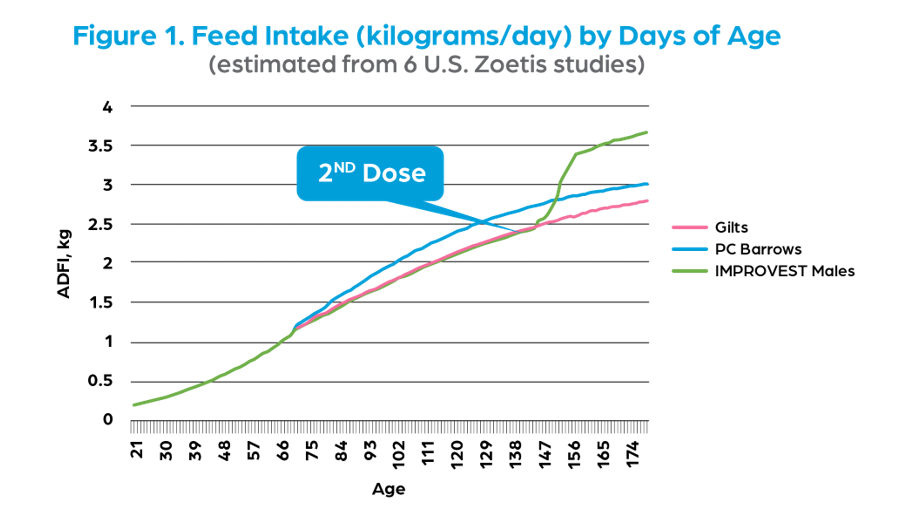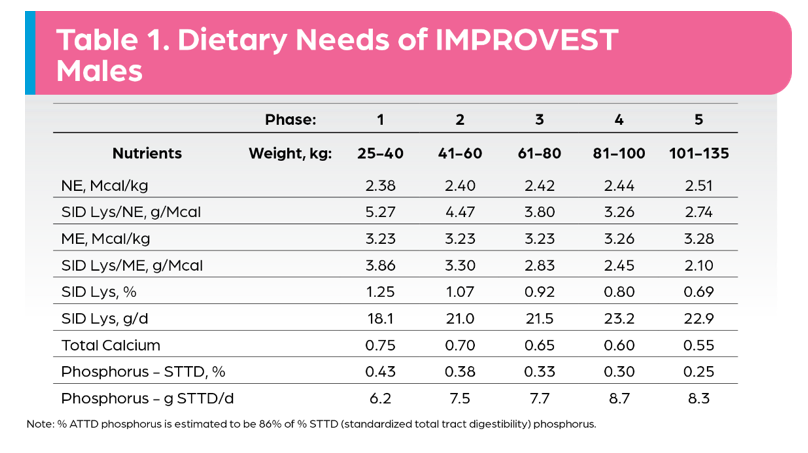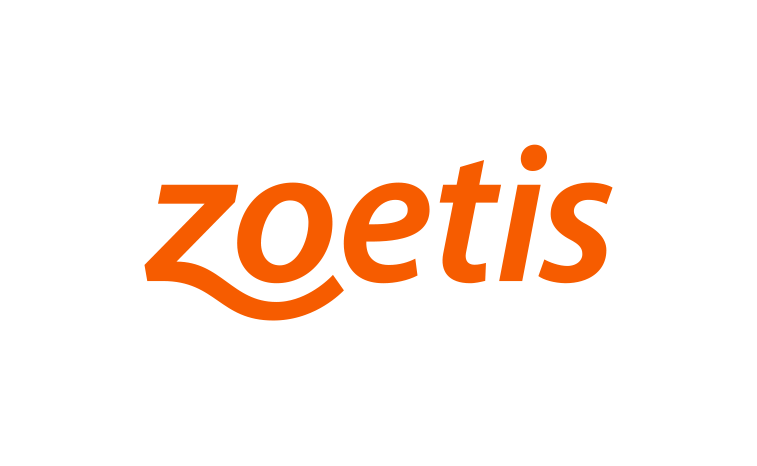



Nutritional specifications for pigs receiving IMPROVEST®
(gonadotropin releasing factor analog-diphtheria toxoid conjugate) 0.2 mg/mLBackground
Feed is the most expensive of all the inputs that are required in producing pork. Therefore, it is important that the diets within a feeding program are properly designed to support the genetic potential of the growing pigs in combination with optimized ingredient costs and marketing conditions to help ensure profitability. Additionally, it is important to understand the impact that IMPROVEST has on designing feeding programs to ensure optimal financial return when using IMPROVEST for both males and females.
The purpose of this document is to provide IMPROVEST users with optimal feeding recommendations for both male and female pigs.
In this document the following feeding management scenarios will be outlined:
- Feeding IMPROVEST males separate from other pigs
- Feeding IMPROVEST females separate from other pigs
- Feeding IMPROVEST males and IMPROVEST females together
- Feeding IMPROVEST females and physically castrated males together
IMPROVEST Males
IMPROVEST is a unique technology that, when used in accordance with the labeling requirements, eliminates the need for physical castration of male pigs, while also suppressing sexual activity and reducing the occurrence of boar taint to the same levels as physically castrated males. A meta-analysis (Bertram et al. 2014) has established that IMPROVEST males support a 4.3% higher rate of gain and an 8.4% improved feed efficiency of gain compared to physically castrated males. These improvements in productivity lead to a monetary advantage favoring IMPROVEST administration for males. Additionally, pork producers are increasingly considering eliminating the practice of physical castration to improve male pig welfare. IMPROVEST provides producers with the opportunity to eliminate physical castration and not increase the risk of taint in these carcasses.
IMPROVEST affects voluntary feed intake. Prior to the second dose of IMPROVEST, when the pig is growing as an intact male, IMPROVEST males have lower levels of voluntary feed intake than physically castrated males. After the second dose of IMPROVEST, when the pig is experiencing immunological suppression of testicular function, IMPROVEST males exhibit a 15%–25% increase in voluntary feed intake as shown in Figure 1 (Puls, 2013). It is this increase in feed intake that leads to an improvement in growth rates and throughput.

Overall, immunological castration with IMPROVEST improves feed conversion while also increasing growth rate, thereby improving throughput which is especially important in a “fixed space” production system.
Feeding the IMPROVEST Male
The nutritional requirements for growing swine vary depending on gender. Intact males have the potential to achieve a higher rate and efficiency of lean gain than physically castrated males but also have a lower voluntary feed intake than physically castrated males and gilts. Due to their lower voluntary feed intake, it is suggested that intact males require a feeding program with a higher amino acid density than traditional diets fed to physically castrated males and gilts to support their higher lean growth potential.
When implementing IMPROVEST for intact males, it is important that diets are properly designed so that the entire pork production chain will benefit. Specifically, achieving optimal rate and efficiency of lean gain and ensuring carcass quality parameters are met will help maximize financial return for the investment in IMPROVEST technology.
There are several nutritional formulation considerations that should be considered when formulating diets for IMPROVEST males. The first consideration in diet formulation for IMPROVEST males is to ensure diets contain an adequate amino acid density for each stage of production. A second important consideration is to ensure diets contain adequate levels of available phosphorus.
Dietary Amino Acid Density for IMPROVEST Males
Intact male pigs have a higher growth rate, lower feed intake, higher lean composition, and therefore, a much-improved feed:gain ratio in comparison to physically castrated males. These collective differences in performance of intact males and physically castrated males implies a likelihood that intact males will respond to a feeding program that is higher in amino acid density.
Several experiments have been performed to evaluate the response of IMPROVEST in male pigs to changes in dietary amino acid density. Research by Elsbernd (2014) demonstrated that the amino acid requirement of IMPROVEST males was about 20% higher than physically castrated males. Rueff et al. (2019) reported that the performance of IMPROVEST males was improved when the amino acid density was increased from 112% of the physically castrated barrow recommendations to 125% of the physically castrated barrow recommendations. Increasing amino acid density from 112% to 125% improved growth rate by 6.62% and feed efficiency by 9.15%.
Additionally, a more in-depth review of the meta-analysis (Bertram et al. 2014), previously discussed above, indicated that studies wherein amino acid density was increased to support the nutritional requirements of the intact male showed that average daily gain was improved by 10.6% and feed efficiency was improved by 13.3% compared to the overall results of 4.3% in average daily gain and 8.4% in feed efficiency noted above.

Table 1 contains basic nutritional information that should be considered when formulating diets and designing feeding programs for the IMPROVEST male. It is important to target SID lysine intakes (g/d) similar to those in Table 1. It is also critical that appropriate “Ideal Protein” principles be applied.
Dietary Phosphorus Density for IMPROVEST Males
IMPROVEST males also have a higher phosphorus requirement than physically castrated males and gilts. Proteinaceous tissue contains nearly 45% of the phosphorus in the body. In the growing intact male, extra phosphorus is required for bone development and lean deposition. Jongbloed (1987) identified a linear relationship between protein deposition and the phosphorus requirement. Table 1 also provides standardized total tract digestibility (STTD) phosphorus recommendations for IMPROVEST males which is 111% of levels used for physically castrated males in all diet phases prior to administering the second IMPROVEST dose (Bertram, 2014). After the second IMPROVEST dose is given, feed intake increases dramatically and it is recommended that the phosphorus density be reduced to 100% of the level used in physically castrated male diets so as not to achieve a greater daily intake of phosphorus than required, thereby reducing the expense of the diet.
Conclusion – IMPROVEST Male
It is concluded that the technical performance of IMPROVEST males is enhanced by feeding diets formulated to be 20%–25% higher in SID lysine density than physically castrated males. Therefore, feed IMPROVEST males a higher dietary SID lysine and phosphorus density (up to second dose) than either physically castrated males or gilts to achieve maximal performance responses and financial return.
Feeding IMPROVEST Females
Treating female pigs with IMPROVEST will suppress estrus following the administration of the second dose. Additionally, feed intake increases following the second dose which supports a commensurate increase in growth rate.
As discussed previously, it is well documented that IMPROVEST males will respond to diets formulated to a higher dietary amino acid density than is required to support optimal performance of physically castrated males and gilts. Do IMPROVEST female and non-treated female pigs respond differently to diets varying in amino acid density? Two experiments were conducted to determine their responses to changes in amino acid density.
The first experiment (Vonnahme et al. 2021) assessed the effect of females with or without IMPROVEST cross-factored with five dietary SID lysine levels (90%, 100%, 110%, 120%, 130%) of NRC (2012) recommendations. Each dietary treatment was comprised of five phases. The SID lysine levels of the 100% dietary treatment were 1.10%, 0.98%, 0.88%, 0.78% and 0.66% respectively, for phases 1 through 5. There was no significant interaction (P=.93) between the main effect of IMPROVEST (yes or no) and dietary lysine density. However, there was a significant main effect of IMPROVEST with IMPROVEST females having 4.2 kg heavier (P<.01) final weights than the non-treated females. The results of this experiment indicate that IMPROVEST females and control females responded to SID lysine levels in the same manner and there was no advantage to feeding IMPROVEST females differently than control females.
A second experiment was performed (Vonnahme et al. 2021) to determine the effects of IMPROVEST (yes or no) when cross-factored with three levels of SID lysine (100%, 110%, 120% of 2012 NRC). Each dietary treatment was represented by a feeding program consisting of five phases. There were no significant interactive effects for average daily gain (P=.395) or market weight (P=.299). However, IMPROVEST females had a 3.4 kg heavier market weight than non-treated females. Additionally, gain:feed ratio was similar between the IMPROVEST treatments (P=.861). The results of this experiment also indicate that IMPROVEST females responded to varying SID lysine levels in a similar manner as non-treated females.
Collectively, the results of the two experiments described above indicate that IMPROVEST females can be fed the same diets as non-treated commercial females.
Conclusion – IMPROVEST Female
It is concluded that IMPROVEST females do not respond to a higher amino acid density regimen when compared with non-treated females. It is recommended that, when feeding IMPROVEST females separate from IMPROVEST males, producers use the same feeding program used to feed non-treated commercial females.
Mixed IMPROVEST Males and IMPROVEST Females
Previously, feeding guidelines were outlined for IMPROVEST males and IMPROVEST females that are fed separately. Many producers house male and female pigs together (in the same pens, rooms and buildings) and therefore cannot provide diets that are unique for each gender.
Conclusion – Mixed IMPROVEST Males and IMPROVEST Female
When feeding mixed gender pens, feed in accordance with IMPROVEST male recommendations. This will ensure that the IMPROVEST males will perform optimally, and it is expected that female performance will be improved from being fed the higher plane of nutrition recommended for IMPROVEST males.
Feeding IMPROVEST Females Mixed with Physically Castrated Males
There may be an occasion when producers opt to commingle IMPROVEST females and physically castrated males within the same pen, room or building. To realize the maximal benefit of IMPROVEST for females, it is important to provide a feeding program that is most closely aligned with the gilt nutrient requirements than for the physically castrated males.
Conclusion – Mixed IMPROVEST Female with Physically Castrated Males
When feeding mixed gender pens of IMPROVEST females with physically castrated males, feed in accordance with the IMPROVEST female recommendations. This will ensure that IMPROVEST females will perform optimally, and it is expected that castrate performance will be improved from being fed the higher plane of nutrition recommended for females.
Feeding Post Second Dose
A final feeding program consideration when feeding IMPROVEST males or females is to account for the effect that IMPROVEST creates on feed intake within days of administering the second dose. Following the second dose of IMPROVEST feed intake increases dramatically (Puls, 2013). Feed intake of IMPROVEST males increases as follows post second dose:
- 8.1% the first week
- 26.1% the second week
- 27.1% the third week
The effect of IMPROVEST on feed intake in males following the second dose of IMPROVEST is shown in Figure 1. It is possible to feed a more dilute diet beginning five days post second dose. Currently, it is recommended that amino acid density, micromineral, vitamins and trace mineral levels be reduced by 5% compared to typical supplementation levels.
Conclusion – Feeding Post Second Dose
It is recommended that a nutritionally dilute diet be fed beginning five days after the second dose of IMPROVEST.
Summary
This document outlines the feeding recommendations for the four possible scenarios of administering IMPROVEST to males and/or females:
- Feeding IMPROVEST males separately
- Feeding IMPROVEST females separately
- Feeding IMPROVEST males and IMPROVEST females together
- Feeding IMPROVEST females and castrates together
IMPORTANT SAFETY INFORMATION: Pregnant women should not administer IMPROVEST. Women of childbearing age should exercise extreme caution when administering this product. Exercise special care to prevent accidental self-injection because of negative effects on reproductive physiology in both men and women. However, there is no risk associated with consuming pork from animals administered this product. Do not use IMPROVEST in male pigs or gilts intended for breeding, or in barrows, cull boars or sows. See full Prescribing Information: https://www.zoetisus.com/improvestpi










